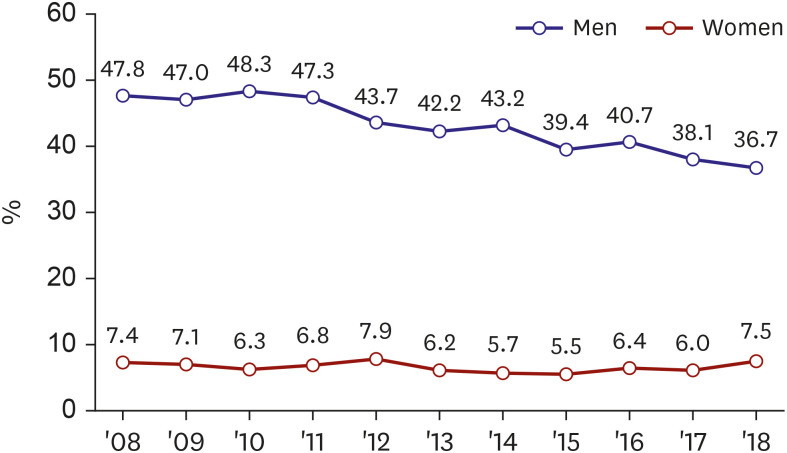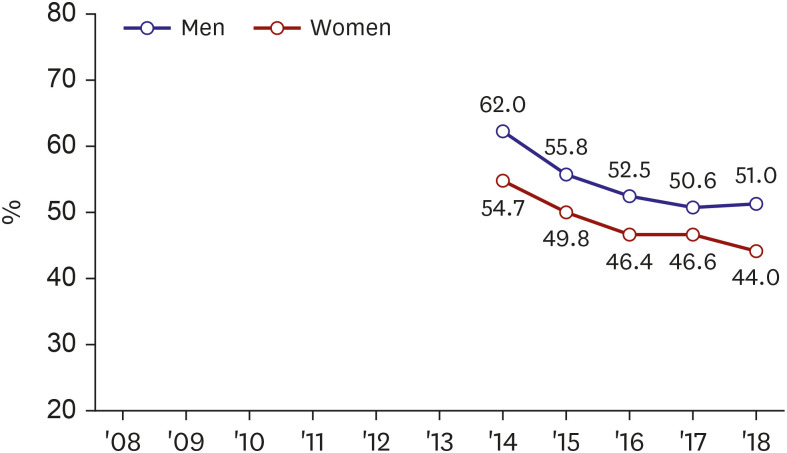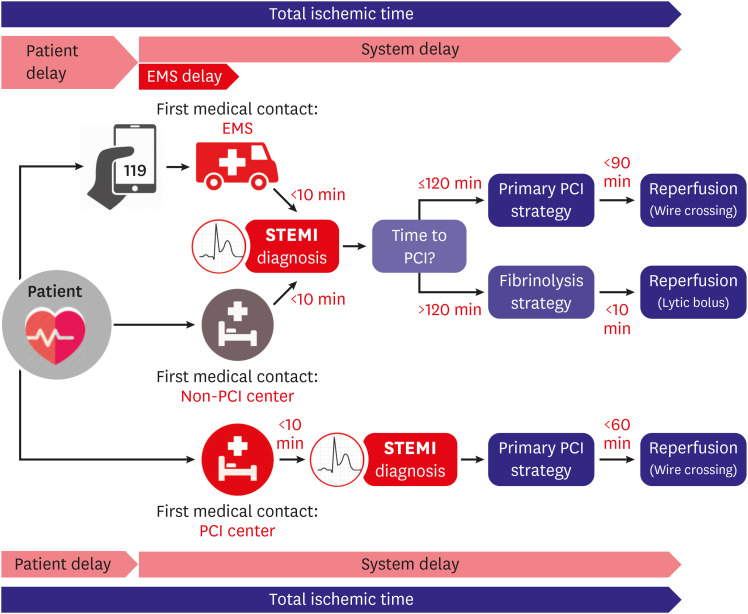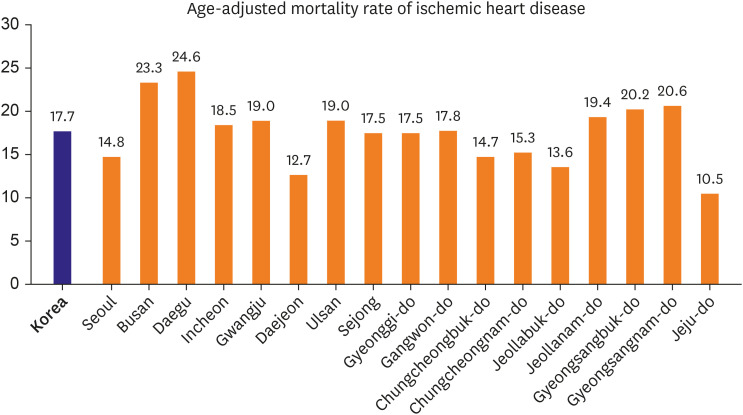2. Chung KS. 2016 Chronic disease status and issue: chronic disease factbook. Cheongju: Korea Centers for Disease Control and Prevention;2016.
3. Kim H, Kim S, Han S, et al. Prevalence and incidence of atherosclerotic cardiovascular disease and its risk factors in Korea: a nationwide population-based study. BMC Public Health. 2019; 19:1112. PMID:
31412823.

4. Organisation for Economic Co-operation and Development. OECD reviews of health care quality: Korea 2012. Paris: OECD Publishing;2012.
5. World Health Organization. WHO global report on trends in prevalence of tobacco use 2000–2025, third edition. Geneva: World Health Organization;2019.
6. World Health Organization. WHO report on the global tobacco epidemic, 2011: waring about the dangers of tobacco. Geneva: World Health Organization;2011.
7. Jee SH, Suh I, Kim IS, Appel LJ. Smoking and atherosclerotic cardiovascular disease in men with low levels of serum cholesterol: the Korea Medical Insurance Corporation Study. JAMA. 1999; 282:2149–2155. PMID:
10591337.
8. Choi S, Chang J, Kim K, et al. Association of smoking cessation after atrial fibrillation diagnosis on the risk of cardiovascular disease: a cohort study of South Korean men. BMC Public Health. 2020; 20:168. PMID:
32013964.

9. Kim HC, Oh SM. Noncommunicable diseases: current status of major modifiable risk factors in Korea. J Prev Med Public Health. 2013; 46:165–172. PMID:
23946874.

11. World Health Organization. The world health report 2002: reducing risks, promoting healthy life. Geneva: World Health Organization;2002.
12. Gaziano TA, Bitton A, Anand S, Abrahams-Gessel S, Murphy A. Growing epidemic of coronary heart disease in low- and middle-income countries. Curr Probl Cardiol. 2010; 35:72–115. PMID:
20109979.

13. de Groot R, van den Hurk K, Schoonmade LJ, de Kort WLAM, Brug J, Lakerveld J. Urban-rural differences in the association between blood lipids and characteristics of the built environment: a systematic review and meta-analysis. BMJ Glob Health. 2019; 4:e001017.

14. Hong JS, Kang HC. Regional differences in treatment frequency and case-fatality rates in Korean patients with acute myocardial infarction using the Korea national health insurance claims database: findings of a large retrospective cohort study. Medicine (Baltimore). 2014; 93:e287. PMID:
25526465.
15. Cho SMJ, Lee H, Pyun WB, Kim HC. Differential control rate of systolic and diastolic blood pressure among Korean adults with hypertension: the Sixth Korean National Health and Nutrition Examination Survey, 2013–2015 (KNHANES VI). Korean Circ J. 2019; 49:1035–1048. PMID:
31190479.

16. Qi Q, Wang X, Strizich G, Wang T. Genetic determinants of type 2 diabetes in Asians. Int J Diabetol Vasc Dis Res. 2015.
17. Kim HK, Jeong MH, Lee SH, et al. The scientific achievements of the decades in Korean Acute Myocardial Infarction Registry. Korean J Intern Med (Korean Assoc Intern Med). 2014; 29:703–712.

18. Kook HY, Jeong MH, Oh S, et al. Current trend of acute myocardial infarction in Korea (from the Korea Acute Myocardial Infarction Registry from 2006 to 2013). Am J Cardiol. 2014; 114:1817–1822. PMID:
25438907.

19. Kim KH, Kim CH, Jeong MH, et al. Differential benefit of statin in secondary prevention of acute myocardial infarction according to the level of triglyceride and high density lipoprotein cholesterol. Korean Circ J. 2016; 46:324–334. PMID:
27275169.

20. Kim HK, Jeong MH, Ahn Y, et al. A new risk score system for the assessment of clinical outcomes in patients with non-ST-segment elevation myocardial infarction. Int J Cardiol. 2010; 145:450–454. PMID:
19541376.

21. Kim HK, Jeong MH, Ahn Y, et al. Hospital discharge risk score system for the assessment of clinical outcomes in patients with acute myocardial infarction (Korea Acute Myocardial Infarction Registry [KAMIR] score). Am J Cardiol. 2011; 107:965–971.e1. PMID:
21256468.

22. Kim Y, Ahn Y, Cho MC, Kim CJ, Kim YJ, Jeong MH. Current status of acute myocardial infarction in Korea. Korean J Intern Med (Korean Assoc Intern Med). 2019; 34:1–10.

23. Sim DS, Jeong MH, Kang JC. Current management of acute myocardial infarction: experience from the Korea Acute Myocardial Infarction Registry. J Cardiol. 2010; 56:1–7. PMID:
20554156.

24. Park HW, Kang MG, Kim K, et al. Association between pulse pressure at discharge and clinical outcomes in patients with acute myocardial infarction: from the KAMIR-Korean-NIH registry. J Clin Hypertens (Greenwich). 2019; 21:774–785. PMID:
31012548.

25. Park JS, Lee HC, Lee HW, et al. Prognosis according to the timing of percutaneous coronary intervention in non-ST segment elevation myocardial infarction, based on the Korean Acute Myocardial Infarction Registry (KAMIR). Cardiol J. 2011; 18:421–429. PMID:
21769823.
26. Sim DS, Jeong MH, Kim HS, et al. Clopidogrel versus aspirin after dual antiplatelet therapy in acute myocardial infarction patients undergoing drug-eluting stenting. Korean Circ J. 2020; 50:120–129. PMID:
31845550.

27. Lee JH, Eom SY, Kim U, et al. Effect of operator volume on in-hospital outcomes following primary percutaneous coronary intervention for ST-elevation myocardial infarction: based on the 2014 cohort of Korean Percutaneous Coronary Intervention (K-PCI) Registry. Korean Circ J. 2020; 50:133–144. PMID:
31845555.

28. Hwang JY. Beginning of KRAMI (Korean Registry of Regional Cardio Cerebrovascular Centers for Acute Myocardial Infarction). In : 2017 Annual Spring Scientific Conference of the KSC in conjunction with KHRS, KSIC, KSE, and KSoLA; 2017 Apr 21–22; Gyeongju, Korea. Seoul: Korean Society of Cardiology;2017.
29. Jernberg T. SWEDEHEART annual report 2019. Stockholm: Danderyd Hospital;2020.
31. National Registry of Disease Office (SG). Singapore Myocardial Infarction Registry annual report 2018: the report of the National Registry of Disease Office. Singapore: Ministry of Health of Singapore;2020.
32. National Cardiovascular Data Registry. Quality improvement for institutions program [Internet]. Washington, D.C.: American College of Cardiology;2020. cited Dec 16, 2020. Available from:
https://cvquality.acc.org/NCDR-Home/about-ncdr.
33. Bufalino VJ, Masoudi FA, Stranne SK, et al. The American Heart Association's recommendations for expanding the applications of existing and future clinical registries: a policy statement from the American Heart Association. Circulation. 2011; 123:2167–2179. PMID:
21482960.
34. Centers for Medicare and Medicaid Services (CMS), HHS. Medicare program; hospital inpatient prospective payment systems for acute care hospitals and the long-term care hospital prospective payment system and Fiscal Year 2014 rates; quality reporting requirements for specific providers; hospital conditions of participation; payment policies related to patient status. Final rules. Fed Regist. 2013; 78:50495–51040. PMID:
23977713.
36. Meltzer SN, Weintraub WS. The role of national registries in improving quality of care and outcomes for cardiovascular disease. Methodist DeBakey Cardiovasc J. 2020; 16:205–211. PMID:
33133356.
37. National cancer control programs in Korea. J Korean Med Sci. 2007; 22 Suppl:S3–4. PMID:
18077892.
38. Lee KS. The role and designation criteria of cardio-cerebrovascular center. Sejong: Ministry of Health and Welfare;2018.
39. Kim A, Yoon SJ, Kim YA, Kim EJ. The burden of acute myocardial infarction after a regional cardiovascular center project in Korea. Int J Qual Health Care. 2015; 27:349–355. PMID:
26271544.

41. Kim SI. Study on improvement measures for ischemic heart disease evaluation. Wonju: Health Insurance Review & Assessment Service;2016.
42. Bae JH. Improving regional inequality in cardiovascular disease incidence and mortality. In : The 63rd Annual Scientific Meeting of the Korean Society of Cardiology; 2019 Oct 18–20; Seoul, Korea. Seoul: Korean Society of Cardiology;2019.
43. O'Gara PT, Kushner FG, Ascheim DD, et al. 2013 ACCF/AHA guideline for the management of ST-elevation myocardial infarction: a report of the American College of Cardiology Foundation/American Heart Association task force on practice guidelines. Circulation. 2013; 127:e362–425. PMID:
23247304.
44. Huber K, Gersh BJ, Goldstein P, Granger CB, Armstrong PW. The organization, function, and outcomes of ST-elevation myocardial infarction networks worldwide: current state, unmet needs and future directions. Eur Heart J. 2014; 35:1526–1532. PMID:
24742888.

45. Ibanez B, James S, Agewall S, et al. 2017 ESC guidelines for the management of acute myocardial infarction in patients presenting with ST-segment elevation: the task force for the management of acute myocardial infarction in patients presenting with ST-segment elevation of the European Society of Cardiology (ESC). Eur Heart J. 2018; 39:119–177. PMID:
28886621.
46. Kim C, Sung J, Lee JH, et al. Clinical practice guideline for cardiac rehabilitation in Korea: recommendations for cardiac rehabilitation and secondary prevention after acute coronary syndrome. Korean Circ J. 2019; 49:1066–1111. PMID:
31646772.












 PDF
PDF Citation
Citation Print
Print




 XML Download
XML Download